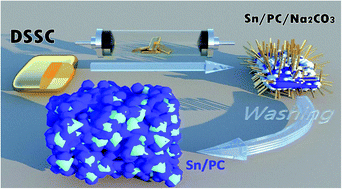A sustainable strategy for fabricating porous carbon supported Sn submicron spheres by self-generated Na2CO3 as templates for lithium-ion battery anode†
Abstract
Green synthesis of porous anode materials with high performance and low cost remains a great challenge for the lithium-ion battery industry at present. Herein, we propose a green strategy to synthesize Sn submicron spheres/porous carbon (denoted as Sn/PC) composites by the direct carbonization of disodium stannous citrate, which is composed of Sn submicron spheres supported by porous carbon. Self-generated Na2CO3 during carbonization serves as the template to support the formation of porous carbon. The obtained porous carbon can efficaciously constrain the aggregation of Sn and prevent the volume expansion of Sn submicron spheres. Such particular structural characteristics endow the Sn/PC electrode with high discharge capacity (588 mA h g−1 after 200 cycles at 100 mA g−1) and long cycle life (431.8 mA h g−1 after 2000 cycles at 1200 mA g−1). Meanwhile, the full cell paired with the LiCoO2 cathode affords a high discharge capacity of 511.4 mA h g−1. The in-depth insights into the lithium storage mechanisms of the electrode are investigated by in situ XRD technique. The conductivity performance for the heterointerface of Sn and C is systematically studied by density functional theory calculations. This green strategy can initiate new horizons for fabricating other anode materials with conspicuous volume expansion.



 Please wait while we load your content...
Please wait while we load your content...